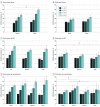Association of Multigenerational Family History of Depression With Lifetime Depressive and Other Psychiatric Disorders in Children: Results from the Adolescent Brain Cognitive Development (ABCD) Study
- PMID: 33881474
- PMCID: PMC8060885
- DOI: 10.1001/jamapsychiatry.2021.0350
Association of Multigenerational Family History of Depression With Lifetime Depressive and Other Psychiatric Disorders in Children: Results from the Adolescent Brain Cognitive Development (ABCD) Study
Abstract
Importance: Three-generation family studies of depression have established added risk of psychopathology for offspring with 2 previous generations affected with depression compared with 1 or none. Because of their rigorous methodology, there are few of these studies, and existing studies are limited by sample sizes. Consequently, the 3-generation family risk paradigm established in family studies can be a critical neuropsychiatric tool if similar transmission patterns are reliably demonstrated with the family history method.
Objective: To examine the association of multigenerational family history of depression with lifetime depressive disorders and other psychopathology in children.
Design, setting, and participants: In this analysis of the Adolescent Brain Cognitive Development (ABCD) study data, retrospective, cross-sectional reports on psychiatric functioning among 11 200 children (generation 3 [G3]) and parent reports on parents' (G2) and grandparents' (G1) depression histories were analyzed. The ABCD study sampling weights were used for generalized estimating equation models and descriptive analyses. Data were collected from September 2016 to November 2018, and data were analyzed from July to November 2020.
Main outcomes and measures: Four risk categories were created, reflecting how many prior generations had history of depression: (1) neither G1 nor G2 (G1-/G2-), (2) only G1 (G1+/G2-), (3) only G2 (G1-/G2+), and (4) both G1 and G2 (G1+/G2+). Child lifetime prevalence and relative risks of psychiatric disorders were based on child and caregiver reports and grouped according to familial risk category derived from G1 and G2 depression history.
Results: Among 11 200 included children, 5355 (47.8%) were female, and the mean (SD) age was 9.9 (0.6) years. By parent reports, the weighted prevalence of depressive disorder among children was 3.8% (95% CI, 3.2-4.3) for G1-/G2- children, 5.5% (95% CI, 4.3-7.1) for G1+/G2- children, 10.4% (95% CI, 8.6-12.6) for G1-/G2+ children, and 13.3% (95% CI, 11.6-15.2) for G1+/G2+ children (Cochran-Armitage trend = 243.77; P < .001). The weighted suicidal behavior prevalence among children was 5.0% (95% CI, 4.5-5.6) for G1-/G2- children, 7.2% (95% CI, 5.8-8.9) for G1+/G2- children, 12.1% (95% CI, 10.1-14.4) for G1-/G2+ children, and 15.0% (95% CI, 13.2-17.0) for G1+/G2+ children (Cochran-Armitage trend = 188.66; P < .001). By child reports, the weighted prevalence of depressive disorder was 4.8% (95% CI, 4.3-5.5) for G1-/G2- children, 4.3% (95% CI, 3.2-5.7) for G1+/G2- children, 6.3% (95% CI, 4.9-8.1) for G1-/G2+ children, and 7.0% (95% CI, 5.8-8.5) for G1+/G2+ children (Cochran-Armitage trend = 9.01; P = .002), and the weighted prevalence of suicidal behaviors was 7.4% (95% CI, 6.7-8.2) for G1-/G2- children, 7.0% (95% CI, 5.6-8.6) for G1+/G2- children, 9.8% (95% CI, 8.1-12.0) for G1-/G2+ children, and 13.8% (95% CI, 12.1-15.8) for G1+/G2+ children (Cochran-Armitage trend = 46.69; P < .001). Similar patterns were observed for other disorders for both parent and child reports and across sex, socioeconomic status, and race/ethnicity.
Conclusions and relevance: In this study, having multiple prior affected generations was associated with increased risk of childhood psychopathology. Furthermore, these findings were detectable even at prepubertal ages and existed in diverse racial/ethnic and socioeconomic groups. Clinically, they underscore the need for screening for family history in pediatric settings and highlight implications for biological research with homogenous subgroups using magnetic resonance imaging or genetic analyses.
Conflict of interest statement
Figures


Comment in
-
Depressionen über drei Generationen.MMW Fortschr Med. 2021 May;163(9):18. doi: 10.1007/s15006-021-9926-3. MMW Fortschr Med. 2021. PMID: 33961237 German. No abstract available.
References
Publication types
MeSH terms
Grants and funding
LinkOut - more resources
Full Text Sources
Other Literature Sources
Medical

